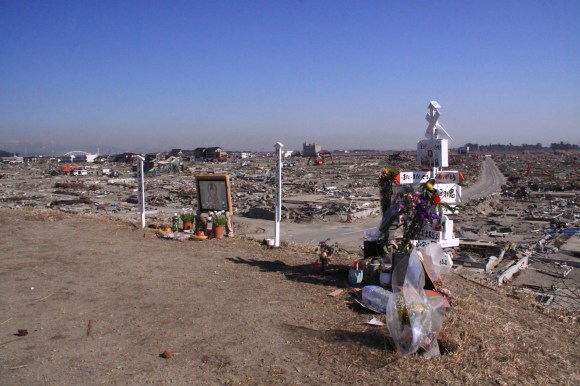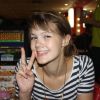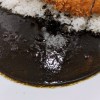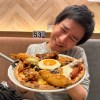
What happens after we die? Is it possible to communicate with loved ones after they are gone? And if not, how can we explain the stories of those who claim to have done so? These questions are pertinent to the work of journalist Shuji Okuno, who researches the yūrei banashi, or ghost stories, of relatives bereaved by the 2011 Tohoku earthquake and tsunami.
Over 18,000 people were killed in the disaster in March 2011, most by drowning; including 2,601 bodies that were never recovered. Okuno has been researching and recording the stories of Tohoku people bereaved by the disaster who say they were visited by the spirits of their deceased family members, often at the exact moment of their passing.
But reporting on ghost sightings in a disaster zone is controversial work. In an interview with Tohoku-area newspaper Kahoku Shimpo this week, Okuno spoke about the stories he has uncovered and the criticism he continues to face.
The journalist and non-fiction writer told the Kahoku Shimpo that he began to research these kind of ghost stories after hearing the accounts of doctors in Natori, a city in Miyagi Prefecture affected by the disaster:
“I heard that there were many people in the disaster zone who had seen spirits. Some doctors said 20 percent of their patients saw them [the spirits or ghosts of dead relatives]. I felt that this was a special phenomenon.”
Asked what kind of stories he has heard, Okuno tells the story of a woman who had lost her much-loved husband in the tsunami. Suffering from severe depression after his death, she had become suicidal, until one day, she saw a vision of her husband, and began to believe that he was watching over her. She became filled with new determination, he says, and decided to live.
There were many other stories like this, according to Okuno: people who gained the strength to live after seeing their loved one’s ghost.
In recording these stories, for which there can be no concrete evidence, Okuno has been condemned as “unscientific”; and he is not the only outlet to be criticised for giving airtime to supernatural stories about the Tohoku disaster. In 2013, NHK broadcast the TV special Nakihito to no “saikai” – hisaichi sandome no natsu ni (‘”Reunions” with the deceased – the [Tohoku] disaster area three summers on’), which told the stories of bereaved family members who say they saw their relatives’ spirits.
These included one woman who felt the presence of her son, killed in the disaster at three years old, playing next to her; she said one of his musical toys started to move on its own. The show also featured an interview with a man who had lost two sons, who saw them both appear before him, and said he heard his older son speak to him. National broadcaster NHK was criticised for the broadcast, which was condemned as an “occult show,” although others applauded the programme, saying it was sensitively made.
For Okuno, the question of whether we believe in ghosts or not is beside the point:
“[It’s not about] whether ghosts are real or not. I tried to accept people’s accounts for what they were, and to tell the stories of those who died, and those left behind.”
He argues that when we encounter things that we can’t explain scientifically, we tend to condemn them “as delusion or fantasy, or we treat them as [mental] health problems.”
Even if these visions are essentially tricks of the mind, Okuno says he has yet to encounter a single negative story, and that his research suggests a “reunion” with a lost loved one is overwhelmingly a positive experience. He stresses the importance of maintaining an open mind: “As long as these ghostly experiences aren’t having any negative effects, I think it’s fine. I want to create an environment where people can talk freely about it.”
Sources: Kahoku Shimpo, Naver Matome, Reisei shinka no michi, NHK, Live Science
Featured image: Wikipedia/ChiefHira

 Japanese Americans tell STORIES FROM TOHOKU
Japanese Americans tell STORIES FROM TOHOKU Man arrested after refusing to wear mask on a plane refuses to wear mask in custody
Man arrested after refusing to wear mask on a plane refuses to wear mask in custody Man who refused to wear mask on airplane in Japan gets arrested four months later
Man who refused to wear mask on airplane in Japan gets arrested four months later Find a red envelope on the ground? Here’s why you should never pick it up
Find a red envelope on the ground? Here’s why you should never pick it up Tohoku tsunami survivor’s $12K camera: heart-felt gift or PR stunt?
Tohoku tsunami survivor’s $12K camera: heart-felt gift or PR stunt? Disney princesses get official manga makeovers for Manga Princess Cafe opening in Tokyo
Disney princesses get official manga makeovers for Manga Princess Cafe opening in Tokyo Randomly running into a great sushi lunch like this is one of the best things about eating in Tokyo
Randomly running into a great sushi lunch like this is one of the best things about eating in Tokyo Beautiful new Final Fantasy T-shirt collection on the way from Uniqlo【Photos】
Beautiful new Final Fantasy T-shirt collection on the way from Uniqlo【Photos】 Is the new Shinkansen Train Desk ticket worth it?
Is the new Shinkansen Train Desk ticket worth it? Kyushu-exclusive Black Mont Blanc goes nationwide in a “Special” way
Kyushu-exclusive Black Mont Blanc goes nationwide in a “Special” way Hey, Japanese taxi driver! Take us to your favorite restaurant in Tsuruga City!
Hey, Japanese taxi driver! Take us to your favorite restaurant in Tsuruga City! Japanese black curry “experiment” takes place at an unlikely restaurant branch in Tokyo
Japanese black curry “experiment” takes place at an unlikely restaurant branch in Tokyo This themed Starbucks in Seoul is hidden away in possibly the coolest location ever
This themed Starbucks in Seoul is hidden away in possibly the coolest location ever How to make an epic pizza at a Japanese family restaurant
How to make an epic pizza at a Japanese family restaurant Beautiful new luxury train for Ishikawa dazzles with gold leaf and lacquer interior
Beautiful new luxury train for Ishikawa dazzles with gold leaf and lacquer interior Our Japanese reporter visits Costco in the U.S., finds super American and very Japanese things
Our Japanese reporter visits Costco in the U.S., finds super American and very Japanese things New Studio Ghibli bedding sets are cool in all senses of the word
New Studio Ghibli bedding sets are cool in all senses of the word We try out “Chan Ramen”, an underground type of ramen popular in the ramen community
We try out “Chan Ramen”, an underground type of ramen popular in the ramen community New Pokémon cakes let you eat your way through Pikachu and all the Eevee evolutions
New Pokémon cakes let you eat your way through Pikachu and all the Eevee evolutions There’s a park inside Japan where you can also see Japan inside the park
There’s a park inside Japan where you can also see Japan inside the park Japanese convenience store packs a whole bento into an onigiri rice ball
Japanese convenience store packs a whole bento into an onigiri rice ball New definition of “Japanese whiskey” goes into effect to prevent fakes from fooling overseas buyers
New definition of “Japanese whiskey” goes into effect to prevent fakes from fooling overseas buyers Foreign English teachers in Japan pick their favorite Japanese-language phrases【Survey】
Foreign English teachers in Japan pick their favorite Japanese-language phrases【Survey】 Uniqlo opens its first Furugi Project secondhand clothing pop-up shop in Tokyo
Uniqlo opens its first Furugi Project secondhand clothing pop-up shop in Tokyo Studio Ghibli releases Kiki’s Delivery Service chocolate cake pouches in Japan
Studio Ghibli releases Kiki’s Delivery Service chocolate cake pouches in Japan Japan’s bone-breaking and record-breaking roller coaster is permanently shutting down
Japan’s bone-breaking and record-breaking roller coaster is permanently shutting down Toyota built a life-sized Miraidon Pokémon and are letting people test drive it this weekend
Toyota built a life-sized Miraidon Pokémon and are letting people test drive it this weekend Foreign passenger shoves conductor on one of the last full runs for Japan’s Thunderbird train
Foreign passenger shoves conductor on one of the last full runs for Japan’s Thunderbird train Kyoto bans tourists from geisha alleys in Gion, with fines for those who don’t follow rules
Kyoto bans tourists from geisha alleys in Gion, with fines for those who don’t follow rules Studio Ghibli unveils Mother’s Day gift set that captures the love in My Neighbour Totoro
Studio Ghibli unveils Mother’s Day gift set that captures the love in My Neighbour Totoro Domino’s Japan now sells…pizza ears?
Domino’s Japan now sells…pizza ears? New Japanese KitKat flavour stars Sanrio characters, including Hello Kitty
New Japanese KitKat flavour stars Sanrio characters, including Hello Kitty Sales of Japan’s most convenient train ticket/shopping payment cards suspended indefinitely
Sales of Japan’s most convenient train ticket/shopping payment cards suspended indefinitely Sold-out Studio Ghibli desktop humidifiers are back so Totoro can help you through the dry season
Sold-out Studio Ghibli desktop humidifiers are back so Totoro can help you through the dry season Japanese government to make first change to romanization spelling rules since the 1950s
Japanese government to make first change to romanization spelling rules since the 1950s Ghibli founders Toshio Suzuki and Hayao Miyazaki contribute to Japanese whisky Totoro label design
Ghibli founders Toshio Suzuki and Hayao Miyazaki contribute to Japanese whisky Totoro label design Doraemon found buried at sea as scene from 1993 anime becomes real life【Photos】
Doraemon found buried at sea as scene from 1993 anime becomes real life【Photos】 Tokyo’s most famous Starbucks is closed
Tokyo’s most famous Starbucks is closed One Piece characters’ nationalities revealed, but fans have mixed opinions
One Piece characters’ nationalities revealed, but fans have mixed opinions We asked a Uniqlo employee what four things we should buy and their suggestions didn’t disappoint
We asked a Uniqlo employee what four things we should buy and their suggestions didn’t disappoint Princesses, fruits, and blacksmiths: Study reveals the 30 most unusual family names in Japan
Princesses, fruits, and blacksmiths: Study reveals the 30 most unusual family names in Japan Studio Ghibli’s new desktop Howl’s Moving Castle will take your stationery on an adventure
Studio Ghibli’s new desktop Howl’s Moving Castle will take your stationery on an adventure We visit a tsunami-ravaged region almost a decade after the Great East Japan Earthquake
We visit a tsunami-ravaged region almost a decade after the Great East Japan Earthquake Outburst by Japanese minister at press conference overshadowed by…his Eva anime tie
Outburst by Japanese minister at press conference overshadowed by…his Eva anime tie North Japan prefecture creates guide to help new foreign workers understand local language quirks
North Japan prefecture creates guide to help new foreign workers understand local language quirks Hana Kimura’s mother slams Terrace House castmates for partying after daughter’s death
Hana Kimura’s mother slams Terrace House castmates for partying after daughter’s death NHK TV worker woken by earthquake, gives viewers a show by accident
NHK TV worker woken by earthquake, gives viewers a show by accident Women speak out about sexual violence after Great East Japan Earthquake
Women speak out about sexual violence after Great East Japan Earthquake Japanese man helps lost Taiwanese tourists, thanks them instead, warms the hearts of netizens
Japanese man helps lost Taiwanese tourists, thanks them instead, warms the hearts of netizens Train driver’s locked tablet with forgotten password leads to big delay on Fukushima line
Train driver’s locked tablet with forgotten password leads to big delay on Fukushima line We turn into paranormal investigators, check out the “world’s scariest” haunted spot in the U.K.
We turn into paranormal investigators, check out the “world’s scariest” haunted spot in the U.K. World famous shadow artist shines a light on Tohoku relief【Art】
World famous shadow artist shines a light on Tohoku relief【Art】 Man reported missing after 2011 Tohoku earthquake found alive and well
Man reported missing after 2011 Tohoku earthquake found alive and well Great East Japan Earthquake: Commemorate eight years and donate with a search on Yahoo! Japan
Great East Japan Earthquake: Commemorate eight years and donate with a search on Yahoo! Japan Heading to a Shinto shrine soon? You might not want to read these ghost stories before you go!
Heading to a Shinto shrine soon? You might not want to read these ghost stories before you go! Japanese company allows workers to take vacation to grieve if favorite idol singer gets married
Japanese company allows workers to take vacation to grieve if favorite idol singer gets married Five years on, Google Maps updates images of areas affected by 2011 earthquake and tsunami
Five years on, Google Maps updates images of areas affected by 2011 earthquake and tsunami
Leave a Reply